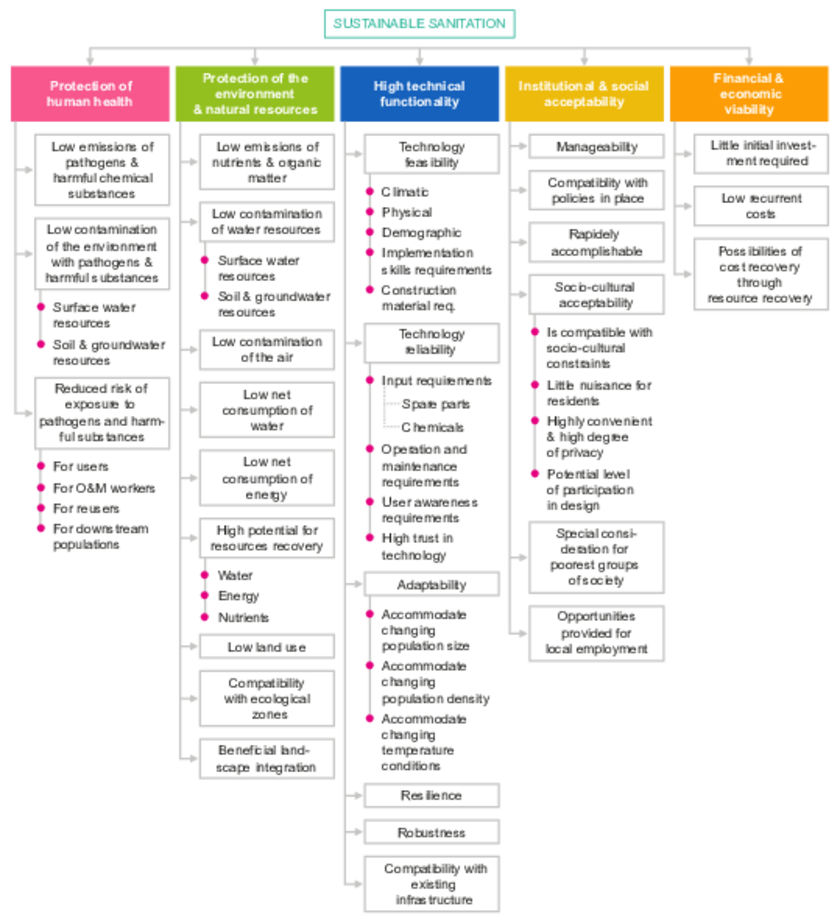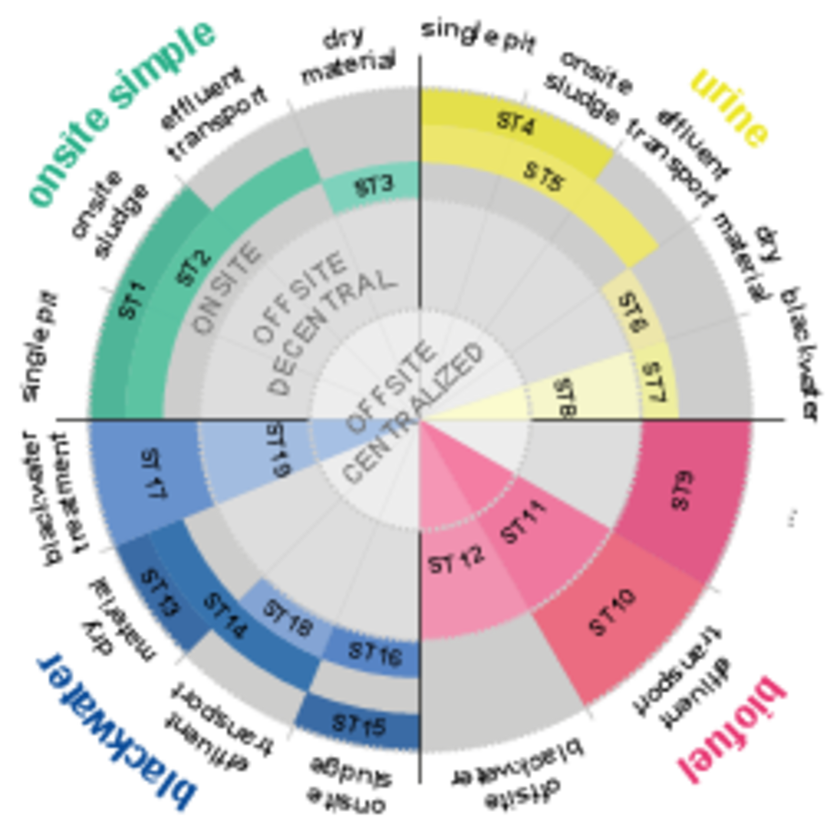Department Urban Water Management
Generation and Assessment of Sanitation Systems for Strategic Planning (GRASP) 2014 - 2020
Selecting a locally appropriate and sustainable sanitation system and its corresponding technologies is a complex multi-criteria decision-making problem. As novel technologies emerge, it becomes increasingly difficult to identify the best option for a given case at hand. Structured decision-making (SDM) can tackle such complex situations by combining environmental engineering and multi-criteria decision analysis (MCDA). So far, most of research focuses on the selection procedure assuming that a set of options to choose from is already given. Yet, every decision support approach is only as good as the alternatives presented. Typically, the creation of sanitation decision options is left over to engineers who lack data and reproducible evaluation methods to make a systematic and transparent preselection. How can the different technologies be assembled into entire systems? How appropriate are the resulting systems for a given application case? And how can we compare their contribution to sustainable development?
This project was designed to provide answers to these questions. It did so by developing systematic and generic methods for the identification of locally appropriate sanitation system options and for the quantification of resource recovery and loss potentials as some relevant sustainability indicators.
The project adopted a design thinking approach in collaboration with case studies and partners in Nepal, Ethiopia, South Africa, and Peru.
This project ended in 2020. The results triggered a follow up project which is described here. Below we describe the main results and outcomes as well as the background and approach.
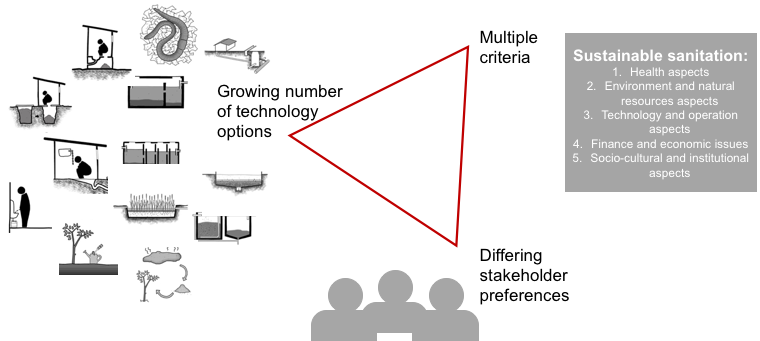
From a decision-making viewpoint, selecting a locally appropriate and sustainable sanitation system and its corresponding technologies is a complex multi-criteria decision-making problem involving multiple sustainability criteria, large number of technology options, and often differing stakeholder preferences. Source: D. Spuhler
Results
The project results include the theoretical description, implementation, and practical applications of methods for: (1) the generation of all valid system configurations from a set of potential technologies considering innovations; (2) the identification of a set of locally appropriate systems as an input into strategic planning using a structured decision-making approach; and (3) the ex-ante quantification of resource recovery potentials of entire systems consider. Local appropriateness is defined by a set of technical, physical, socio-cultural, demographic, and managerial criteria. Resources are defined by four substances which are total nitrogen and phosphorus as nutrients, total solids as an indicator for carbon and energy, and water.
The main scientific contributions are that the methods are:
- generic to be applied to any case or (future) technology;
- flexible to fit into any international established planning procedures;
- and automated to consider a diverse and large set of potential options.
The main practical implications are that the methods:
- are systematic to enhance transparency and for more empirical decision making;
- enable the consideration of novel options which one might not have thought of based on knowledge or experience along;
- and that more appropriate and resource efficient can be given priority in the planning process, thereby contributing to sustainable sanitation and circular economy.
As more technology and sanitation system options are added to the already large portfolio, the methods presented in this thesis may become an essential tool for the operationalization of SDG 6 and SDG 11, sustainable, inclusive, and circular sanitation and cities for all.
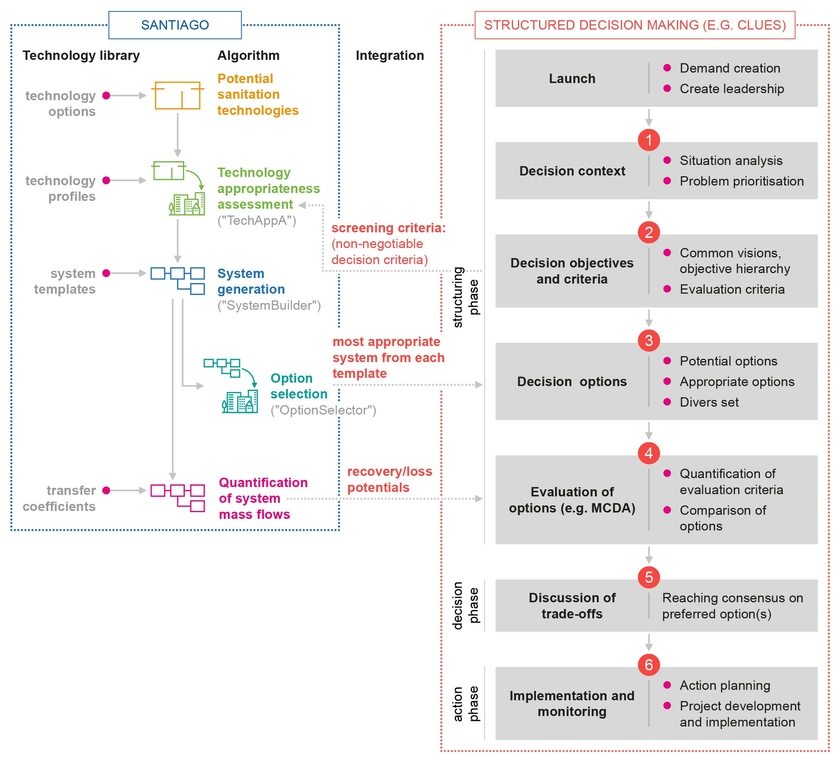
This project contributed with three methods implemented in the SANitation sysTem Alternative GeneratOr (Santiago). Santiago is designed to support structured decision making frameworks for urban sanitation such as CLUES (Lüthi et al., 2011) or Sanitation 21 (Parkinson et al., 2014). Source: (Spuhler et al., 2020a)
Products
The methods are freely available online in a software called Santiago (SANitation sysTem Alternative GeneratOr) and are complemented with a technology library providing the required data for more than 40 technologies.
The theoretical description is documented in a the PhD thesis of D. Spuhler and a number of peer-reviewed and general publications:
- (Spuhler et al., 2020a): Spuhler, D., Germann, V., Kassa, K., Ketema, A.A., Sherpa, A.M., Sherpa, M.G., Maurer, M., Lüthi, C. and Langergraber, G. 2020a. Developing sanitation planning options: a tool for systematic consideration of novel technologies and systems. Journal of Environmental Management 271. DOI: 10.1016/j.jenvman.2020.111004.
- (Spuhler et al., 2020b): Spuhler, D., Scheidegger, A. and Maurer, M. 2020b. Comparative analysis of sanitation systems for resource recovery: influence of configurations and single technology components. Water Research 186. DOI: 10.1016/j.watres.2020.116281.
- (Spuhler et al., 2020c): Spuhler, D., Scheidegger, A. and Maurer, M. 2020c. Ex-ante quantification of nutrient, total solids, and water flows in sanitation systems. Submitted to Journal of Environmental Management.
- (Spuhler et al., 2018): Spuhler, D., Scheidegger, A. and Maurer, M. 2018. Generation of sanitation system options for urban planning considering novel technologiesWater Research 145, 259-278. DOI: 10.1016/j.watres.2018.08.021.
- (Spuhler and Lüthi, 2020): Spuhler, D. and Lüthi, C. 2020. Review of frameworks and tools for urban strategic sanitation planning: considering technology innovations and sustainability. Journal of Water Sanitation and Hygiene for Development. DOI: 10.2166/washdev.2020.062.
- (Spuhler and Lüthi, 2018): Spuhler, D. and Lüthi, C. 2018 Pre-selecting appropriate sanitation system options as an input into urban sanitation planning, Water Engineering and Development Centre (WEDC), Nakuru, Kenya.
- (Spuhler and Roller, 2020): Spuhler, D. and Roller, L. 2020. Sanitation technology library: details and data sources for appropriateness profiles and transfer coefficients, Eawag - Swiss Federal Institute of Aquatic Science and Technology, Dübendorf. DOI: doi.org/10.25678/0000ss.
Motivations
To make urban water management more sustainable, many novel sanitation technologies and system configurations have been developed recently. Many of these innovations allow for resource recovery and reuse and are independent from energy, water, and sewer networks. This makes them more resilient to changing environmental and socio-demographic conditions and thus more appropriate for developing urban areas.
But while novel technologies and systems potentially enhance sustainability, they also increase planning complexity. The high number of inoperative facilities worldwide shows quite dramatically that there are some substantial deficits with the non-technical issues of the implementation. Conventional sanitation planning approaches have been top-down, expert-driven and focusing on toilet infrastructure provision and leaving out other important aspects such as wastewater treatment downstream or user acceptance. This has led to inappropriate technology choices, lack of ownership and a high number of failing facilities. The situation is particularly challenging in expanding urban areas of developing countries, where most of the global population growth is currently taking place. We claim that the problem will be reduced if sanitation planning is improved by providing more appropriate and sustainable sanitation system options.
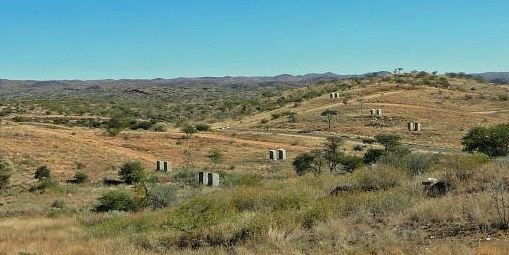
Project objectives
The general aim of this project was to improve sanitation planning by developing systematic and generic methods to identify locally appropriate and sustainable sanitation system decision options.
The methods fulfill three preconditions:
- They consider entire sanitation systems from the toilet to reuse or disposal;
- are applicable to a large and diverse range of technologies and system configurations;
- and integrate criteria from all sustainability dimensions.
The methods integrate themselves into a structured decision-making (SDM) framework such as community-led urban environmental sanitation (CLUES) or Sanitation21. In order to be applicable to novel concepts and expanding urban areas in developing countries, the methods should allow dealing with different types of uncertainties.
The three specific objectives of the project were:
- To develop a systematic method for the generation of locally appropriate sanitation system decision options at the structuring phase of the decision-making process.
- To develop a generic method for the quantification of resource recovery potentials suitable for the comparison of a diverse and large range of sanitation systems.
- To develop a standardized procedure for the integration of the methods with structured decision-making in expanding urban areas and to evaluate their contribution.
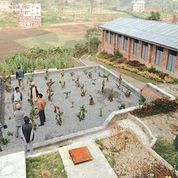
Community-managed decentralized wastewater treatment plant located in Sunga, Madhyapur Thimi Municipality, Kathmandu, Nepal. The plant is designed for 200 households and consists of a screen and grit chamber, a settler, an anaerobic baffled reactor (ABR), two parallel horizontal flow wetlands and two parallel vertical flow wetlands, and a sludge drying bed. The construction was partially financed by the municipality, which provides also funds for daily operation and maintenance activities carried out by a paid caretaker. The treated wastewater is discharged into the river and not reused at this stage. The biogas can be used by the nearby school. Source: WaterAid/ Marco Betti
Approach
Sustainable sanitation systems not only provide appropriate technologies to protect the human health and the environment; they are also socially acceptable, and financially and institutionally viable. SDM can assist decision-makers to clarify trade-offs between different decision options by combining multi-criteria decision analysis (MCDA) and environmental engineering. However, decisions are only as good as the decision options presented. So far, the identification of decision options was based on expert assessment, often randomly assembled. The current rapid technological development in the field of sanitation requires a more systematic procedure that provides input for the decision-making process.
Objective hierarchy for sustainable sanitation based on the five sustainability criteria of the Sustainable Sanitation Alliance (SuSanA, 2008). Source: (Spuhler et al., 2020a)
Sustainability challenges us to shift the focus from basic infrastructure provision towards more systematic approaches including optimal resources utilization and closing material cycles at the lowest possible level. This means we have to consider various technical, financial, social and environmental criteria. Currently there is a lack of generic models to quantify such diverse indicators for sanitation systems others than sewer-based ones at the scale of an urban settlement. A substance flow model based on mass balances to estimate material use and emissions could provide relevant performance indicators at scale.
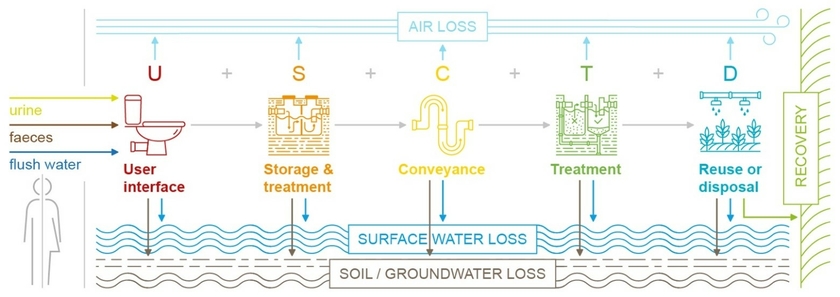
A Sanitation System is a context-specific series of technologies and services for the management of human wastes (or resources), from the point of generation to the point of reuse or disposal. This includes five functional groups: the user interface (U), the collection and storage (S), conveyance (C), treatment (T), and final reuse or disposal (D). To quantify resource recovery and loss ratios, substance flows are modelled along the system allowing to then quantify how much of inflowing mass of substance is either lost, transferred, or can be recovered, Source: (Spuhler et al., 2020c)
Methods
Generation of locally appropriate sanitation system options (Objective 1). To provide a systematic method that can deal with a large and diverse set of technology and system options, a computer model was developed that contains three algorithms for: (i) the evaluation of technology appropriateness based on a number of non-negotiable screening criteria (e.g. water availability, socio-cultural acceptance); (ii) the generation of all valid system configurations from the appropriate technologies; and (iii) for the selection of a set of locally appropriate sanitation system options, which is diverse but of manageable size. The diversity of the options is defined by 19 system templates, categories of systems based on technological characteristics (e.g. onsite simple, urine diversion, biofuel systems, or blackwater). A technology library compiles the required data for 41 conventional and novel technologies and 27 screening criteria based on international literature and expert judgement. To account for uncertainties related to technology implementation or local contexts, the screening criteria are quantified using probability distributions.
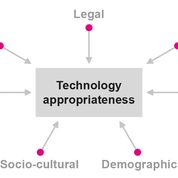
Factors affecting technology appropriateness that can help identify screening criteria.
Quantification of resource recovery potentials (Objective 2). To quantify ex-ante substance flows, an additional algorithm was added. The algorithm uses generic transfer coefficients from literature to quantify flows of total phosphorus, total nitrogen, total solids (as indicator for energy and organic matter) and water. These mass flows are then used to quantify resource recovery potentials as well as losses to the soil, surface water, and air. The uncertainty of the transfer coefficient, expressed by the variability of literature data, is modelled using the Dirichlet distribution and Monte Carlo.
To characterise the diversity of the sanitation system option space we used nine binary conditions in order to define 19 different system templates that characterise systems according to different paradigms (onsite simple, urine diversion, biofuel, blackwater) and their degree of centralization. Source: (Spuhler et al., 2020a)
Integration with SDM (Objective 3). For the practical application of the methods), a procedure for the integration with SDM was developed. The integration requires three elements : (i) a list of screening criteria for the appropriateness assessment; (ii) evaluation data to characterize the application case and technology profile for the screening attributes; and (iii) the desired number of sanitation system decision options. The screening criteria are derived from the decision objectives for sustainable sanitation developed in one or two facilitated stakeholder workshops. The evaluation data is based on secondary literature for the application case and the library for the technology options. The desired and manageable number of decision options depends on the complexity of the methods used for the final selection and lies between 3 and over 50. To support the interaction with the stakeholders, a generic objective hierarchy for sustainable sanitation and a master list of screening criteria was developed based on literature.
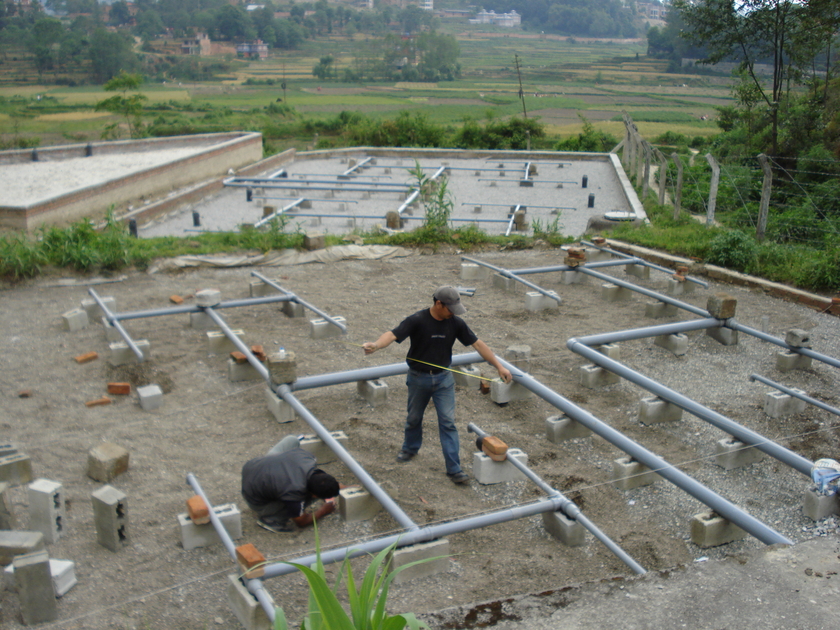
Construction of a decentralized treatment plant to generate biogas from municipal wastewater and treat the effluent in horizontal flow wetlands (Dhulikhel Municipality, Nepal). The plant is sized for 200 households (Influent quality: BOD 90mg/L, COD 406mg/L) and requires not electricity. A local caretaker, paid through selling of biogas, is carrying out operation and maintenance works. Source: ENPHO (2008)
References
Lüthi, C., Morel, A., Tilley, E. and Ulrich, L. (2011) Community-Led Urban Environmental Sanitation Planning (CLUES), Swiss Federal Institute of Aquatic Science and Technology (Eawag), Dübendorf, Switzerland.
Parkinson, J., Lüthi, C. and Walther, D. (2014) Sanitation 21. A Planning Framework for Improving City-wide Sanitation Service, International Water Association (IWA), London.
Spuhler, D., Germann, V., Kassa, K., Ketema, A.A., Sherpa, A.M., Sherpa, M.G., Maurer, M., Lüthi, C. and Langergraber, G. 2020a. Developing sanitation planning options: a tool for systematic consideration of novel technologies and systems. Journal of Environmental Management 271. DOI: 10.1016/j.jenvman.2020.111004.
Spuhler, D. and Lüthi, C. 2018 Pre-selecting appropriate sanitation system options as an input into urban sanitation planning, Water Engineering and Development Centre (WEDC), Nakuru, Kenya.
Spuhler, D. and Lüthi, C. 2020. Review of frameworks and tools for urban strategic sanitation planning: considering technology innovations and sustainability. Journal of Water Sanitation and Hygiene for Development. DOI: 10.2166/washdev.2020.062.
Spuhler, D. and Roller, L. 2020 Sanitation technology library: details and data sources for appropriateness profiles and transfer coefficients, Eawag - Swiss Federal Institute of Aquatic Science and Technology, Dübendorf. DOI: doi.org/10.25678/0000ss.
Spuhler, D., Scheidegger, A. and Maurer, M. 2018. Generation of sanitation system options for urban planning considering novel technologies. Water Research 145, 259-278. DOI: 10.1016/j.watres.2018.08.021.
Spuhler, D., Scheidegger, A. and Maurer, M. 2020b. Comparative analysis of sanitation systems for resource recovery: influence of configurations and single technology components. Water Research 186. DOI: 10.1016/j.watres.2020.116281.
Spuhler, D., Scheidegger, A. and Maurer, M. 2020c. Ex-ante quantification of nutrient, total solids, and water flows in sanitation systems. Submitted to Journal of Environmental Management. Preprint available in the associated data package: doi.org/10.25678/0000HH.
Partners
Environmental and Public Health Organization (ENPHO), Kathmandhu, Nepal, Link
Arba Minch University (AMU), Ethiopia, Department of Water Supply and Environmental Engineering
University for Natural Ressources and Life Science (BOKU), Vienna, Institute for Sanitary Engineering and Water Pollution Control, Link
Institut für Automation und Kommunikation (ifak), Magdeburg, Department for Water andEnergy, Link

